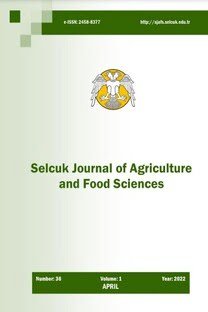Buğday çeşitlerinde borun çimlenme üzerine etkisinin in vitro ve saksı şartlarında araştırılması
Orta Güney Anadolu tarım bölgesinde yaygın olarak yetiştirilen makarnalık (Triticum durum Desf, Kızıltan-91, Kunduru-1149, Selçuklu-97) ve ekmeklik (Triticum aestivum L., Bezostoja-1, Gerek-79, Gün-91) buğday çeşitlerinde farklı bor (B) uygulamalarının çimlenme üzerine etkileri in vitro ve saksı denemeleri ile araştırılmıştır. In vitro denemeler 200 mi'lik cam kavanozlarda, %0.7 ağar, %3 sakkaroz ve sırasıyla; O, 1.08, 3.24, 9.72, 29.16ppmB içeren 50 ml MS besin ortamında, saksı denemeleri ise (O, 1.08, 3.24, 9.72, 29.16 ppm B) bor ihtiva eden toprakta yürütülmüştür. Tüm denemeler "Tesadüfparsellerinde faktöriyel deneme desenine" göre 3 tekerrürlü olarak kurulmuştur. Çimlenme üzerine bor dozlarının etkisi her iki şartta da önemli bulunmazken, çeşitlerin ve çeşit x bor interaksiyonun etkisi ise önemli bulunmuştur. Araştırma sonucunda bitki besin maddelerinin etkilerini belirlemede in vitro denemelerin saksı ve tarla çalışmalarına alternatif bir metot olarak tavsiye edilebileceği ve buğdayda çimlenmeyi engelleyecek minimum bor seviyesi eşiği ile ilgili çalışmaların incelendiği durumlarda en düşük B dozu olarak 29.16 ppm dozunun dikkate alınması gerekmektedir. Çünkü bu doz ve daha düşük dozlar çimlenmeyi etkilememiştir.
Anahtar Kelimeler:
bor, borlu gübreler, buğday, saksı denemeleri, çimlenme, İç Anadolu Bölgesi
Investigation of the effect of boron on seed germination of wheat cultivars at in vitro and pot conditions
The effect of varying boron (B) concentrations on seed germination of the most commonly cultivated bread (Triticum aestivum L.) and durum (Triticum durum Desf.) -wheat cultivars (Bezostoja-1, Gerek-79, Gun-91 and Kızıltan-91, Kunduru-1149, Selcuklu-97, respectively) in Central Anatolia were investigated by in vitro and pot experiments. In vitro experiments were carried out in 200 ml jars containing 50 ml MS with 0.7 % agar, 3 % sucrose and different concentrations of B (0, 1.08, 3.24, 9.72, 29.16 ppm); pot experiments were also done in 0, 1.08, 3.24, 9.72, 29.16 ppm B added pots. The experiments were set up according to completely randomized design with 3 replications. Although B concentrations had no significant effect on seed germination in all cultivars, cultivar and cultivar x B interactions were significant. It is suggested that in vitro studies can be an alternative approach to pot and field studies in determining the responses of plants to microelements. However, if determination of B level inhibiting seed germination is the primary research target B levels higher than 29.16 ppm B should be considered as the minimum threshold to set up the experiments becasue B levels at or lower than this threshold did not seem to effect germination rates in the cultivars studied.
Keywords:
boron, boron fertilizers, wheat, pot experimentation, germination, Central Anatolia Region,
___
- Atalay, E., 2003. Buğday (Kızıltan-91) ve arpa (Tokak-157/37) in vitro fidelerinde bor alımının ICP-AES ile tespiti. S.Ü. Fen Bilimleri Enstitüsü Yüksek Lisans Tezi, Konya.
- Anonim, 2001. Tarımsal Yapı ve Üretim. DİE. Ankara. Bagheri, A., Paull, J.G., Rathjen, A.J., Ali, S.M., Moody, D.B., 1992. Genetic variation in the response of pea (Pisum sativum L.) to high soil contentrations of boron. Plant and Soil. 146:1-2, 261-269.
- Düzgüneş, O., Kesici, T., Kavuncu, O., Gürbüz, F., 1987. Araştırma ve Deneme Metodları (İstatistik Metodları-II), Ankara Üniversitesi Ziraat Fakültesi Yayınları, Yayın no: 1021, Ders kitabı: 285, Ankara.
- Keren, R., Bingham, F.T., 1985. Boron in Water, Soil and Plants. In Adv. In Soil Sci. Stewart B.A.(ed.) Vol.1: 229-276.
- Gezgin, S., Dursun, N., Hamurcu, M., Harmankaya, M., Önder, M., Sade, B., Topal, A., Soylu, S., Akgün, N., Yorgancilar, M., Ceyhan, E., Çiftçi, N., Acar, B., Gültekin, İ., Işık, Y., Şeker, C., Babaoğlu, M., 2002. Determination of B Contents Of Soils in Central Anatolian Cultivated Lands and its Relations between Soil and Water Characteristics. Boron in Plant and Animal Nutrition. Edited by Goldbach et al., Kluwer Academic / Plenum Publishers, New York. s. 391-400.
- Lima, M.D.R., 1998. Seed germination of pea ( Pisum sativum L.) under different concentration boron levels. IRRIGA. 3:1, 47-54.
- Murashige, T., Skoog, F., 1962. A revised medium for rapid growth and bioassays with tobacco tissue cultures. Physiol. Plant. 15:473-497.
- MSTAT-C., 1980. MStat User’s Quides Statistics (Version 5 ed.) Michigan State Universty. Michigan, USA.
- Paull, J.G., Cartwright, B., Rathjen, A.J., 1988. Responses of wheat and barley genotypes to toxic concentrations of soil boron. Euphytica. 39: 137-144.
- Paliwal, K.V. ve Mehta, K.K., 1973. Interactive effect of salinity, SAR and boron on germination and growth of seedlings of some paddy (Oryza sativa) varieties. Plant and Soil (Historical Archive), Springer Science+Business Media B.V., Formerly Kluwer Academic Puplishers B.V., Cilt: 39, Sayı: 3, s: 603-609.
- Reisenauer, H. M., Walsh, L. M., and R. G., Hoeft, 1973. Testing Soils for Sulphur, Boron, Molybdenum, and Chlorine. In Walsh L.M., and Beaton J.D. (Eds.), Soil Testing and Plant Analysis. Soil Science Society of America. Madison, Wisconsin, USA, pp. 173-200.
- Taner, S., 2003. Bor Toksik Alanda Yetiştirilen Makarnalık Buğday (Triticum durum L.) Genotiplerinin Verim ve Bazı Verim Ögelerinin Belirlenmesi. S.Ü. Fen Bilimleri Enstitüsü Yüksek Lisans Tezi, Konya.
- Torun, A., Yılmaz, A., Kalaycı, M., Gültekin, İ., Torun, B., Eker, S., Çakmak, İ., 1999. Konya koşullarında yetiştirilen farklı buğday çeşitlerinin bor toksitesine duyarlılığının sera ve tarla koşullarında araştırılması. Hububat Sempozyumu, Altıncı oturum: Hububat Yetiştirme, 317-327 8-11 Haziran, Konya.
- ISSN: 1300-5774
- Yayın Aralığı: Yılda 3 Sayı
- Başlangıç: 2018
- Yayıncı: Selçuk Üniv. Ziraat Fak.
Sayıdaki Diğer Makaleler
Buğday çeşitlerinde borun çimlenme üzerine etkisinin in vitro ve saksı şartlarında araştırılması
MUSTAFA YORGANCILAR, Mehmet BABAOĞLU
Bazı gübrelerin Trichoderma harzianum' un misel gelişimi ve spor üretimine etkisi
Çiğdem KÜÇÜK, Merih KIVANÇ, Engin KINACI, Gülcan KINACI
Bitkilerin hastalıklara karşı dayanıklılığında konukçu enzimlerin rolü
Türkiye' de üretilen bazı meyve suyu ve konsantresinde patulin miktarının HPLC ile belirlenmesi
Sarımsak dişlerinin vakumla tutulmasına etkili bazı parametrelerin belirlenmesi
CEMALETTİN SARIÇOBAN, MUSTAFA KARAKAYA
Bor uygulamasının nohut (Cicer arietinum L.) çeşitlerinde verim ve bazı verim unsurlarına etkileri
Hakan BAYRAK, MUSTAFA ÖNDER, Sait GEZGİN
